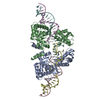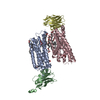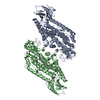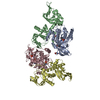[English] 日本語
 Yorodumi
Yorodumi- PDB-7rhz: Heterodimer of Cre recombinase mutants D33A/A36V/R192A and R72E/L... -
+ Open data
Open data
- Basic information
Basic information
| Entry | Database: PDB / ID: 7rhz | ||||||
|---|---|---|---|---|---|---|---|
| Title | Heterodimer of Cre recombinase mutants D33A/A36V/R192A and R72E/L115D/R119D in complex with loxP DNA. | ||||||
 Components Components |
| ||||||
 Keywords Keywords | RECOMBINATION/DNA / Cre /  recombinase / dimer / recombinase / dimer /  loxP / RECOMBINATION-DNA complex loxP / RECOMBINATION-DNA complex | ||||||
| Function / homology |  Function and homology information Function and homology information | ||||||
| Biological species |   Escherichia phage P1 (virus) Escherichia phage P1 (virus) | ||||||
| Method |  ELECTRON MICROSCOPY / ELECTRON MICROSCOPY /  single particle reconstruction / single particle reconstruction /  cryo EM / Resolution: 4.48 Å cryo EM / Resolution: 4.48 Å | ||||||
 Authors Authors | Stachowski, K. / Foster, M.P. | ||||||
| Funding support |  United States, 1items United States, 1items
| ||||||
 Citation Citation |  Journal: Nucleic Acids Res / Year: 2022 Journal: Nucleic Acids Res / Year: 2022Title: Mechanisms of Cre recombinase synaptic complex assembly and activation illuminated by Cryo-EM. Authors: Kye Stachowski / Andrew S Norris / Devante Potter / Vicki H Wysocki / Mark P Foster /  Abstract: Cre recombinase selectively recognizes DNA and prevents non-specific DNA cleavage through an orchestrated series of assembly intermediates. Cre recombines two loxP DNA sequences featuring a pair of ...Cre recombinase selectively recognizes DNA and prevents non-specific DNA cleavage through an orchestrated series of assembly intermediates. Cre recombines two loxP DNA sequences featuring a pair of palindromic recombinase binding elements and an asymmetric spacer region, by assembly of a tetrameric synaptic complex, cleavage of an opposing pair of strands, and formation of a Holliday junction intermediate. We used Cre and loxP variants to isolate the monomeric Cre-loxP (54 kDa), dimeric Cre2-loxP (110 kDa), and tetrameric Cre4-loxP2 assembly intermediates, and determined their structures using cryo-EM to resolutions of 3.9, 4.5 and 3.2 Å, respectively. Progressive and asymmetric bending of the spacer region along the assembly pathway enables formation of increasingly intimate interfaces between Cre protomers and illuminates the structural bases of biased loxP strand cleavage order and half-the-sites activity. Application of 3D variability analysis to the tetramer data reveals constrained conformational sampling along the pathway between protomer activation and Holliday junction isomerization. These findings underscore the importance of protein and DNA flexibility in Cre-mediated site selection, controlled activation of alternating protomers, the basis for biased strand cleavage order, and recombination efficiency. Such considerations may advance development of site-specific recombinases for use in gene editing applications. | ||||||
| History |
|
- Structure visualization
Structure visualization
| Movie |
 Movie viewer Movie viewer |
|---|---|
| Structure viewer | Molecule:  Molmil Molmil Jmol/JSmol Jmol/JSmol |
- Downloads & links
Downloads & links
- Download
Download
| PDBx/mmCIF format |  7rhz.cif.gz 7rhz.cif.gz | 274.2 KB | Display |  PDBx/mmCIF format PDBx/mmCIF format |
|---|---|---|---|---|
| PDB format |  pdb7rhz.ent.gz pdb7rhz.ent.gz | 219.6 KB | Display |  PDB format PDB format |
| PDBx/mmJSON format |  7rhz.json.gz 7rhz.json.gz | Tree view |  PDBx/mmJSON format PDBx/mmJSON format | |
| Others |  Other downloads Other downloads |
-Validation report
| Arichive directory |  https://data.pdbj.org/pub/pdb/validation_reports/rh/7rhz https://data.pdbj.org/pub/pdb/validation_reports/rh/7rhz ftp://data.pdbj.org/pub/pdb/validation_reports/rh/7rhz ftp://data.pdbj.org/pub/pdb/validation_reports/rh/7rhz | HTTPS FTP |
|---|
-Related structure data
| Related structure data |  24472MC  7rhxC  7rhyC M: map data used to model this data C: citing same article ( |
|---|---|
| Similar structure data |
- Links
Links
- Assembly
Assembly
| Deposited unit | 
|
|---|---|
| 1 |
|
- Components
Components
| #1: Protein | Mass: 38493.094 Da / Num. of mol.: 1 / Mutation: D33A, A36V, R192A Source method: isolated from a genetically manipulated source Source: (gene. exp.)   Escherichia phage P1 (virus) / Gene: cre / Production host: Escherichia phage P1 (virus) / Gene: cre / Production host:   Escherichia coli (E. coli) / References: UniProt: P06956 Escherichia coli (E. coli) / References: UniProt: P06956 |
|---|---|
| #2: Protein | Mass: 38526.906 Da / Num. of mol.: 1 / Mutation: R72E, L115D, R119D Source method: isolated from a genetically manipulated source Source: (gene. exp.)   Escherichia phage P1 (virus) / Gene: cre / Production host: Escherichia phage P1 (virus) / Gene: cre / Production host:   Escherichia coli (E. coli) / References: UniProt: P06956 Escherichia coli (E. coli) / References: UniProt: P06956 |
| #3: DNA chain | Mass: 13491.689 Da / Num. of mol.: 1 / Source method: obtained synthetically / Source: (synth.)   Escherichia phage P1 (virus) Escherichia phage P1 (virus) |
| #4: DNA chain | Mass: 13602.748 Da / Num. of mol.: 1 / Source method: obtained synthetically / Source: (synth.)   Escherichia phage P1 (virus) Escherichia phage P1 (virus) |
-Experimental details
-Experiment
| Experiment | Method:  ELECTRON MICROSCOPY ELECTRON MICROSCOPY |
|---|---|
| EM experiment | Aggregation state: PARTICLE / 3D reconstruction method:  single particle reconstruction single particle reconstruction |
- Sample preparation
Sample preparation
| Component | Name: Heterodimer of Cre recombinase mutants D33A/A36V/R192A and R72E/L115D/R119D in complex with loxP DNA Type: COMPLEX / Entity ID: all / Source: MULTIPLE SOURCES | |||||||||||||||||||||||||
|---|---|---|---|---|---|---|---|---|---|---|---|---|---|---|---|---|---|---|---|---|---|---|---|---|---|---|
| Molecular weight | Value: 0.1005 MDa / Experimental value: YES | |||||||||||||||||||||||||
| Source (natural) | Organism:   Escherichia phage P1 (virus) Escherichia phage P1 (virus) | |||||||||||||||||||||||||
| Buffer solution | pH: 7 Details: Buffer was made fresh from solid reagents and filtered with a 0.22 um filter. | |||||||||||||||||||||||||
| Buffer component |
| |||||||||||||||||||||||||
| Specimen | Conc.: 5 mg/ml / Embedding applied: NO / Shadowing applied: NO / Staining applied : NO / Vitrification applied : NO / Vitrification applied : YES : YES | |||||||||||||||||||||||||
| Specimen support | Details: 20 mA Pelco easiGLOW / Grid material: GOLD / Grid mesh size: 300 divisions/in. / Grid type: Quantifoil R1.2/1.3 | |||||||||||||||||||||||||
Vitrification | Instrument: FEI VITROBOT MARK IV / Cryogen name: ETHANE-PROPANE / Humidity: 100 % / Chamber temperature: 277 K |
- Electron microscopy imaging
Electron microscopy imaging
| Experimental equipment |  Model: Titan Krios / Image courtesy: FEI Company |
|---|---|
| Microscopy | Model: TFS KRIOS |
| Electron gun | Electron source : :  FIELD EMISSION GUN / Accelerating voltage: 300 kV / Illumination mode: FLOOD BEAM FIELD EMISSION GUN / Accelerating voltage: 300 kV / Illumination mode: FLOOD BEAM |
| Electron lens | Mode: BRIGHT FIELD Bright-field microscopy / Nominal magnification: 81000 X / Nominal defocus max: 3000 nm / Nominal defocus min: 1000 nm / C2 aperture diameter: 100 µm / Alignment procedure: ZEMLIN TABLEAU Bright-field microscopy / Nominal magnification: 81000 X / Nominal defocus max: 3000 nm / Nominal defocus min: 1000 nm / C2 aperture diameter: 100 µm / Alignment procedure: ZEMLIN TABLEAU |
| Specimen holder | Cryogen: NITROGEN / Specimen holder model: FEI TITAN KRIOS AUTOGRID HOLDER / Temperature (max): 86 K / Temperature (min): 86 K |
| Image recording | Average exposure time: 2 sec. / Electron dose: 60 e/Å2 / Film or detector model: GATAN K3 BIOQUANTUM (6k x 4k) / Num. of grids imaged: 1 / Num. of real images: 4306 / Details: 45 total frames |
| EM imaging optics | Energyfilter name : GIF Bioquantum / Energyfilter slit width: 15 eV : GIF Bioquantum / Energyfilter slit width: 15 eVSpherical aberration corrector  : Microscope was modified with a Cs corrector with two hexapoles. : Microscope was modified with a Cs corrector with two hexapoles. |
| Image scans | Width: 5760 / Height: 4096 |
- Processing
Processing
| EM software |
| ||||||||||||||||||||||||||||||||||||||||||||
|---|---|---|---|---|---|---|---|---|---|---|---|---|---|---|---|---|---|---|---|---|---|---|---|---|---|---|---|---|---|---|---|---|---|---|---|---|---|---|---|---|---|---|---|---|---|
CTF correction | Type: PHASE FLIPPING AND AMPLITUDE CORRECTION | ||||||||||||||||||||||||||||||||||||||||||||
| Particle selection | Num. of particles selected: 1277272 | ||||||||||||||||||||||||||||||||||||||||||||
3D reconstruction | Resolution: 4.48 Å / Resolution method: FSC 0.143 CUT-OFF / Num. of particles: 256734 / Symmetry type: POINT | ||||||||||||||||||||||||||||||||||||||||||||
| Atomic model building | B value: 150.3 / Protocol: FLEXIBLE FIT / Space: REAL / Target criteria: Correlation Coefficient | ||||||||||||||||||||||||||||||||||||||||||||
| Atomic model building | PDB-ID: 2HOI Pdb chain-ID: A / Pdb chain residue range: 20-343 |
 Movie
Movie Controller
Controller












 PDBj
PDBj







































